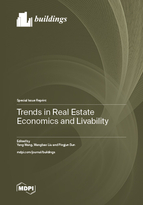Trends in Real Estate Economics and Livability
A special issue of Buildings (ISSN 2075-5309). This special issue belongs to the section "Architectural Design, Urban Science, and Real Estate".
Deadline for manuscript submissions: closed (10 March 2025) | Viewed by 45977
Special Issue Editors
Interests: real estate; housing market; urban planning; livable environment
Interests: built environment and spatial behavior; residential differentiation; social space
Interests: urban planning; shrinking cities
Special Issues, Collections and Topics in MDPI journals
Special Issue Information
Dear Colleagues,
This Special Issue reports on emerging trends in real estate economics and urban livability research. This will help to address the pressing challenges presented by megacities and livability issues. It is a well-known fact that major global megacities suffer from reduced livability due to high housing costs, housing inequality, and residential land scarcity. In contrast, some small and medium-sized cities are experiencing urban shrinkage due to migration, housing vacancy, and depressed real estate markets. Therefore, promoting healthy and sustainable real estate market development is required to improve urban livability.
This new Special Issue, hosted by the scientific journal Buildings, aims to garner excellent contributions and high-impact articles examining academic topics of urban construction and living space from the perspective of real estate economics and livability.
Prof. Dr. Yang Wang
Prof. Dr. Wangbao Liu
Prof. Dr. Pingjun Sun
Guest Editors
Manuscript Submission Information
Manuscripts should be submitted online at www.mdpi.com by registering and logging in to this website. Once you are registered, click here to go to the submission form. Manuscripts can be submitted until the deadline. All submissions that pass pre-check are peer-reviewed. Accepted papers will be published continuously in the journal (as soon as accepted) and will be listed together on the special issue website. Research articles, review articles as well as short communications are invited. For planned papers, a title and short abstract (about 100 words) can be sent to the Editorial Office for announcement on this website.
Submitted manuscripts should not have been published previously, nor be under consideration for publication elsewhere (except conference proceedings papers). All manuscripts are thoroughly refereed through a single-blind peer-review process. A guide for authors and other relevant information for submission of manuscripts is available on the Instructions for Authors page. Buildings is an international peer-reviewed open access semimonthly journal published by MDPI.
Please visit the Instructions for Authors page before submitting a manuscript. The Article Processing Charge (APC) for publication in this open access journal is 2600 CHF (Swiss Francs). Submitted papers should be well formatted and use good English. Authors may use MDPI's English editing service prior to publication or during author revisions.
Keywords
- real estate development
- residential space structure
- housing vacancy
- shrinking cities
- residential mobility
- gentrification
- built environment
- livable city
- residential location
- urban planning
- urban renewal
Benefits of Publishing in a Special Issue
- Ease of navigation: Grouping papers by topic helps scholars navigate broad scope journals more efficiently.
- Greater discoverability: Special Issues support the reach and impact of scientific research. Articles in Special Issues are more discoverable and cited more frequently.
- Expansion of research network: Special Issues facilitate connections among authors, fostering scientific collaborations.
- External promotion: Articles in Special Issues are often promoted through the journal's social media, increasing their visibility.
- Reprint: MDPI Books provides the opportunity to republish successful Special Issues in book format, both online and in print.
Further information on MDPI's Special Issue policies can be found here.








